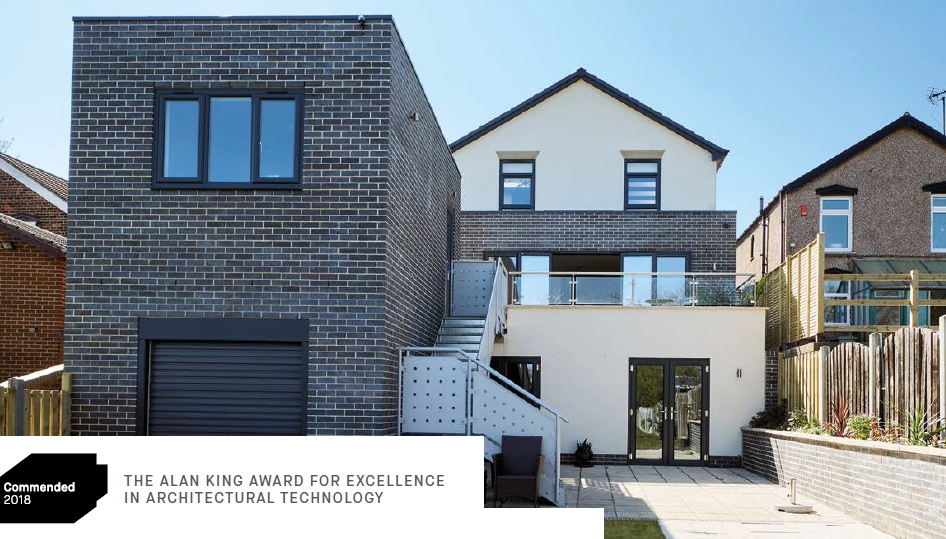Stead Street, Eckington

|
The Stead Street project responds to the clients demand for a contemporary building within its setting that contributes to amenity.
The client required the home was inclusive of her needs as a partially-sighted person. As the client is likely to remain at home more than other homeowners, due to both circumstances and the running of a business from home, the building was designed and constructed to reduce energy consumption running costs and is therefore highly insulated.
The dwelling incorporates a modern design within a traditional Edwardian street scene. It features contemporary use of hard wearing and low maintenance materials, yet reflects the design principles of both surrounding buildings, and the original dwelling it replaces.
This was achieved using a mix of modern and traditional materials and by making use of colour changes and design details to highlight key building features. In order to optimise use of the narrow site, balanced with key client requirements, a highly insulated traditional system was used with a silicon render finish. The surrounding buildings are in part render finished with brick, so it was important that the new building reflected this.
Timber frame construction was considered, but as the new building had a requirement for a basement, with substantial retaining walls to support neighbouring buildings, it was considered more appropriate to use traditional building methods. This allowed us to retain existing trades onsite, to reduce complication and delay and to accommodate the complex design to the rear of the property.
The building has been designed at the rear to be ‘tiered’, with the largest footprint in the lower ground floor being 17.5 metres long, with each floor above set back by an average of three metres. This makes best use of north facing light, to achieve natural light in what would otherwise be dark rooms, through the use of light wells on flat roof areas. This was a key point for our client, as there are times when she is able to see objects and have moments of enjoyment, when rooms are brighter. Meeting these technological requirements required a close working relationship with specialist flat roof manufacturers and installation companies.
The project was planned carefully to consider the removal of the existing building and excavation of the site, with timed pickups for lorries to take away materials along the narrow one-way street.
The buildings inclusivity was clearly a key point, and it was designed to accommodate the client’s needs both now, and in the future. The design incorporated features such as keyless entry into the building, sensors and a range of different alarms to communicate different messages. A range of different textures and finishes were thoughtfully considered, to ‘communicate’ to the client where she is in her home, which floor, which room or where she is externally. This allows her to be independent in her own home.
The bedroom layout was designed so that an alternative layout could be provided by the removal of non-loadbearing walls, to provide an additional bedroom. This in fact was implemented shortly before completion onsite, due to the client receiving the exciting news that she was expecting a child. The impending arrival of an additional family member meant that what had been previously designed for years in the future was seamlessly incorporated prior to practical completion.

|
The Stead Street project was commended in CIAT’s 2018 Alan King award for excellence in architectural technology. The Judge’s comments were:
| Careful consideration and understanding of the end users’ unique needs required a thoughtful and sensitive approach together with an element of lateral thinking that has created and delivered a lifetime home that both meets and exceeds the client’s current and future needs. |
This article originally appeared in CIAT’s Architectural Technology Journal, published in Autumn 2018. It was written by France and Associates
--CIAT
[edit] Related articles on Designing Buildings Wiki
- AgriSTEM.
- Alterations and extension to The Grange.
- Architectural technician.
- Architectural technologist - delineation of roles.
- Architectural technologist.
- Architectural Technology Awards 2017.
- Architectural Technology Awards 2018.
- CIAT
- Gresham's School Britten Building.
- Old Gale Farm, Ambleside
- The Engine Shed.
Featured articles and news
RTPI leader to become new CIOB Chief Executive Officer
Dr Victoria Hills MRTPI, FICE to take over after Caroline Gumble’s departure.
Social and affordable housing, a long term plan for delivery
The “Delivering a Decade of Renewal for Social and Affordable Housing” strategy sets out future path.
A change to adoptive architecture
Effects of global weather warming on architectural detailing, material choice and human interaction.
The proposed publicly owned and backed subsidiary of Homes England, to facilitate new homes.
How big is the problem and what can we do to mitigate the effects?
Overheating guidance and tools for building designers
A number of cool guides to help with the heat.
The UK's Modern Industrial Strategy: A 10 year plan
Previous consultation criticism, current key elements and general support with some persisting reservations.
Building Safety Regulator reforms
New roles, new staff and a new fast track service pave the way for a single construction regulator.
Architectural Technologist CPDs and Communications
CIAT CPD… and how you can do it!
Cooling centres and cool spaces
Managing extreme heat in cities by directing the public to places for heat stress relief and water sources.
Winter gardens: A brief history and warm variations
Extending the season with glass in different forms and terms.
Restoring Great Yarmouth's Winter Gardens
Transforming one of the least sustainable constructions imaginable.
Construction Skills Mission Board launch sector drive
Newly formed government and industry collaboration set strategy for recruiting an additional 100,000 construction workers a year.
New Architects Code comes into effect in September 2025
ARB Architects Code of Conduct and Practice available with ongoing consultation regarding guidance.
Welsh Skills Body (Medr) launches ambitious plan
The new skills body brings together funding and regulation of tertiary education and research for the devolved nation.
Paul Gandy FCIOB announced as next CIOB President
Former Tilbury Douglas CEO takes helm.
UK Infrastructure: A 10 Year Strategy. In brief with reactions
With the National Infrastructure and Service Transformation Authority (NISTA).























